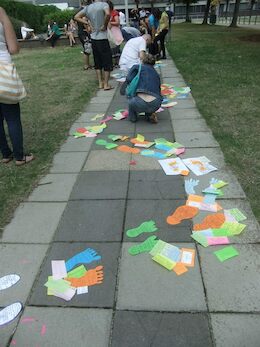Toolbox — For Training and Youth Work
All new tools in your inbox: Be the first to know about new tools for learning with our e-mail notifications.
Exercise, Group Building Activity
Footprints in the Park
Partnership building and project promotion for future cooperation - a highly interactive tool incorporating all learning styles to maximise your anticipated outcomes and a cornucopia of brand new projects for Erasmus+
Aims of the tool
To facilitate the promotion of new project ideas and build partnerships that are realistic and relevant.
by:
furnishing the participants with practical information about Erasmus+ to the workers
scaffolding a workshop to elicit the topics and actions that are meaningful and relevant to the young people
marrying them up using the 3 new key actions of Erasmus+
providing an opportunity for dialogue to take place between the young people and the workers to decide upon concrete projects in the new programme
showcasing the new project ideas for all participating promoters/countries to view and allow the cooperation process to begin
The structure of this tool provides a clear and logical path for all to follow which leads both the organisations and young people down a path that produces real project ideas generated by the young people and supported by the workers.
Description of the tool
Part 1 (one morning)
1. Divide the workers and the young people into 2 groups.
2. Provide organisational information about Erasmus+ and its possibilities to the workers using non-formal methods to make it memorable.
3. Meanwhile, give the young people an outline of Erasmus+ by using an interactive method such as flashcards comprising all the possibilities in each of the 3 Key Actions. Suggestion: invite the participants to take a card if they have been involved in this kind of project. Elicit from them what it was, eg. youth exchange, EVS, etc. This provided a peer learning opportunity to the group. The flashcards are placed on the wall to form word clouds.
4. Left to discover are the new possibilities planned for 2014 such as the cross-sectorial work with CSR, etc. Give trainer input to explain what each new option is.
5. De-nest those present using a non-formal method to form groups of 5/6.
6. Each group to discuss the hot topics for young people that they are passionate about working on from 2014 onwards.
7. Use the moderation card method to elicit the proposals from each group.
8. Agree on 5 or 6 topics depending on the number in the group.
9. Invite them to choose the topic they are most interested in and form new groups so they can look at the different ways each theme can be tackled in the framework of the possibilities in Erasmus+.
10. Each group uses the Rich Picture Method to produce their own manifesto: http://www.chrisshipton.co.uk/graphicrecording/
Part II (the afternoon)
11. Presentation of the manifestos to youth workers.
12. Youth workers and young people team up again from the same organisation.
13 They take a walk in the park to discuss the wish list of the young people within the framework of Erasmus+
14. Outside if possible, they prepare 'footprints', either with coloured card and a wealth of other arts and crafts materials or they paint on their feet using suitable paints and make their own footprints. One for each project idea.
15 The left foot displays their name, organisation, country, email, Skype, Facebook, website. The right foot contains their kind of project proposal, eg. Youth exchange, EVS, and the theme/topic, eg gender issues, environmental, and finally a request for who or what you are looking for, eg 4 programme countries, a partner from Spain, 12 participants.
16 Place the footprints on the path and secure with Blutak to create a trail.
17 Invite the group to follow the footprints and find partners/projects
18 If they are interested in cooperating they complete a post-it note with their name, country, organisation and contact details and put it on the footprint.
Disclaimer
SALTO cannot be held responsible for the inappropriate use of these training tools. Always adapt training tools to your aims, context, target group and to your own skills! These tools have been used in a variety of formats and situations. Please notify SALTO should you know about the origin of or copyright on this tool.
Tool overview

http://toolbox.salto-youth.net/1457
This tool is for
Youth workers and young people
and addresses
Networking and Follow-up
It is recommended for use in:
Action 3.1 (Cooperation with the Neighbouring Partner Countries)
Action 4.3 (Training and Networking)
Materials needed:
Part 1
Information about Erasmus+ for the workers
Flash cards for the word clouds about Erasmus+ for the young people
Coloured paper/card for the moderation method plus markers
A large roll of paper or several large pieces for each group plus black markers/felt pens of varying degrees of thickness. Coloured markers
Part 2
Coloured card, markers, glitter, paint, sponges to paint feet, wipes to clean feet, scissors, Blutak, music, post-it notes
Duration:
Part 1 = 1 half day
Part 2 = 1 half day
Behind the tool
The tool was created by
Sue Dudill
in the context of
The Janus Project - UK NA and Momentum World's evaluation of the last 7 years of Youth in Action
The tool has been experimented in
Seminar
The tool was published to the Toolbox by
Sue Dudill (on 14 November 2013)
and last modified
11 August 2013
Comments
No comments have been posted yet.
If you want to comment on this tool, you need to be signed in with your MySALTO account. Sign in now